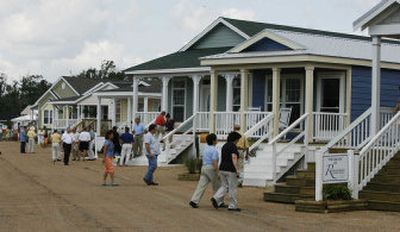‘Recovery Expo’ aims to facilitate rebuilding

BILOXI, Miss. – It is a sort of post-Katrina state fair. A trade show custom-tailored for a ruined land. A convergence of building and zoning experts, readily accessible bureaucrats and salespeople who have just the extra-thick siding you’ve been looking for – the kind with the patented Twister Lock and Cyclonic Locking System that withstands winds as high as 187 mph!
Mississippi Gov. Haley Barbour is billing it as the first “Recovery Expo,” a free event that opened Friday at the Mississippi Coast Coliseum and runs through the weekend. Organizers are hoping the state’s hurricane victims will leave here with their legal questions answered, a prefab home picked out, and renewed energy that will help the long-suffering coast bloom with building projects as the one-year anniversary of the storm approaches on Aug. 29.
So far, Mississippi’s rebuilding effort has been heartening and frustrating. Thousands of Gulf Coast residents are still in trailer homes, and many waterfront communities are strewn with ghostly husks of businesses and homes.
But Gavin Smith, the state recovery director, says momentum is starting to build here: Residents are receiving their insurance payouts, and small business loans are sprucing up commercial properties. Last month, the state began distributing a portion of $5 billion in federal rebuilding aid to 17,000 homeowners. The ravaged Beau Rivage Casino, once one of the region’s fanciest, is set for an Aug. 29 grand re-opening.
“We think we’re right at the cusp of the point where people will start building in earnest,” Smith said.
Some of the most ardent believers in that forecast were the dozens of building industry representatives who dominated the Expo. If the style of their message owed a debt to Dale Carnegie, the substance took a cue from the little pig who built with bricks. Their names alone set the theme: Kodiak Steel Homes; Safeway Homes; House Raising of the Gulf Coast LLC; FloodBarrier, Inc.
A company called Oceansafe Housing hawked a hurricane-proof home with walls made from a kind of steel and polystyrene sandwich. Employee Susanne Bohr said the idea has been a success in the Caribbean.
“A NASA engineer holds the patent,” she said.
A salesman named Steve Bishop offered an array of hurricane-proof doors and windows. He was hoping to hook up with some big condo developers. He had some advice for them, too: build the high-rises with multilevel car garages on the first few floors.
“Then you’re going to lose cars, not people,” he said.
One booth touted the “DuPont Storm Room,” with a model on display. It seemed normal enough, about the size of a guest bathroom. But the accompanying text noted that it was reinforced with Kevlar: “The same life-saving fiber used in bullet-resistant vests.”
Neil Smith, the DuPont distributor, said the storm room doesn’t make much sense directly in the flood zone, but could be helpful a couple of miles from the beach, where the greatest danger from a hurricane is wind damage rather than water.
Blake Hobson, who was there pitching the siding with the “cyclonic” technology, said companies like his stood to make money on the coast in the coming years. “This whole place has got to be rebuilt,” he said.
A number of exhibitors touted their pre-fabricated houses, which these days go by the name “modular” housing, to sidestep trailer-park stigmas. Across the Gulf Coast region, officials are hoping that architecturally spiffed-up versions of this old, affordable idea will help bring long-term housing to the region, and fast.
Barbour, who kicked off the event Friday morning, said that with chronic labor shortages, the region has to rely on homes that are at least partially assembled in a factory.
“We have to replace 70,000 units of housing,” Barbour said, referring to the number of homes destroyed or rendered uninhabitable by the storm. “We’ve never built more than 2,800 units of housing on the Mississippi Gulf Coast in one year.”
The expo also hosted a number of government agencies to answer questions about job training programs, evacuation routes and new height requirements for houses. A Federal Emergency Management Agency booth displayed a “Home Builder’s Guide to Coastal Construction.”
The arena itself was severely flooded in the storm – its Web site shows large waves coursing across the main floor. As Mississippians crowded the exhibit area Friday, a work crew was hammering away nearby, fixing up a section of the building that still had no windows.